Business Finance: Module MOD003319 Assignment Analysis
VerifiedAdded on 2022/12/23
|7
|1310
|28
Homework Assignment
AI Summary
This assignment solution addresses key concepts in business finance, focusing on the differences between profit and cash flow, and the components of working capital including receivables, inventory, and payables. It analyzes the impact of changes in working capital on a company's cash flow, explaining how investments in short-term assets can affect liquidity. The solution also outlines practical steps that companies can take to improve cash flow through effective working capital management, such as implementing attractive payment terms, automating account receivables, managing inventory, and maintaining strong supplier and customer relationships. The assignment uses examples to illustrate these concepts and provides a comprehensive understanding of financial management principles.
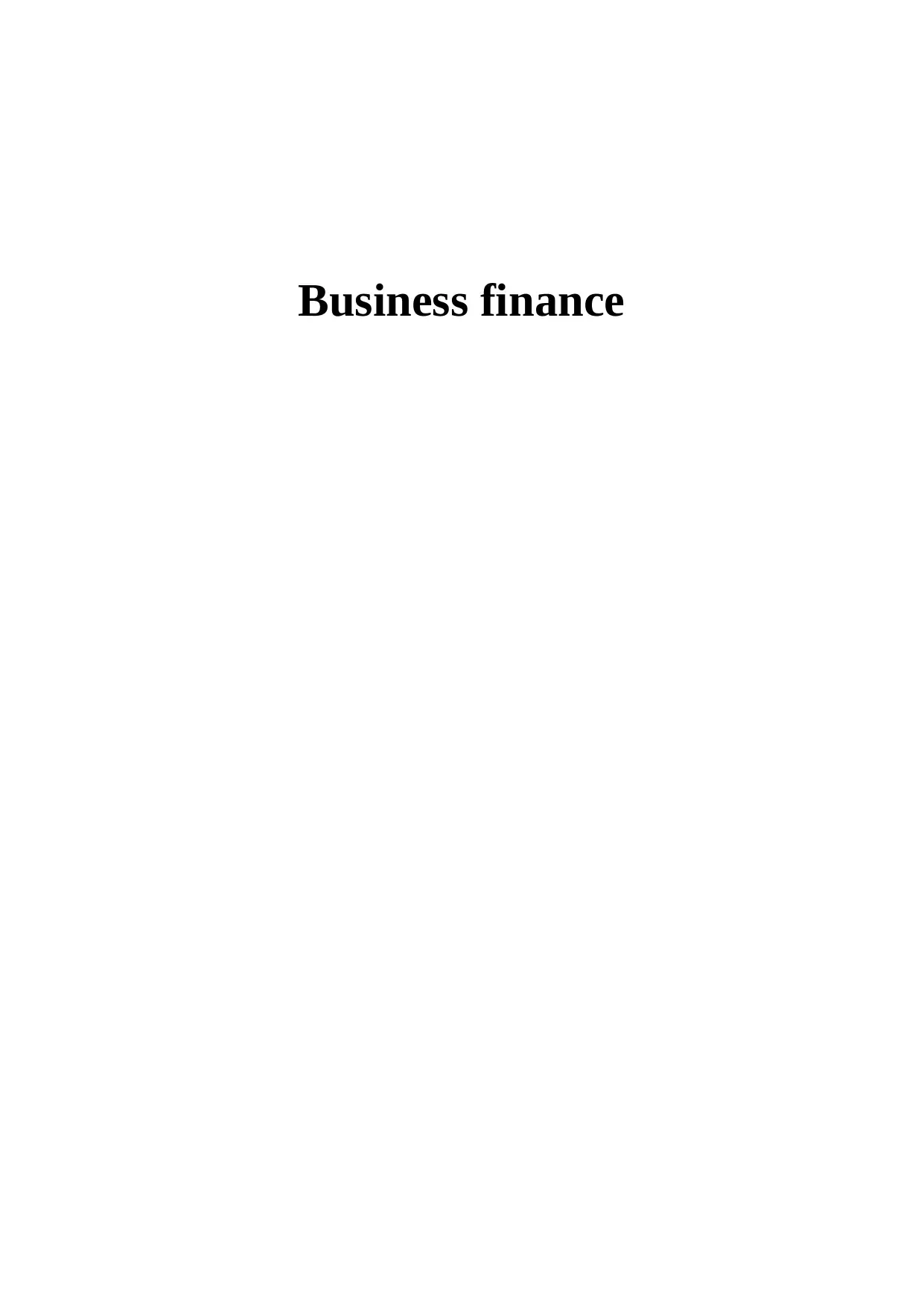
Business finance
Paraphrase This Document
Need a fresh take? Get an instant paraphrase of this document with our AI Paraphraser
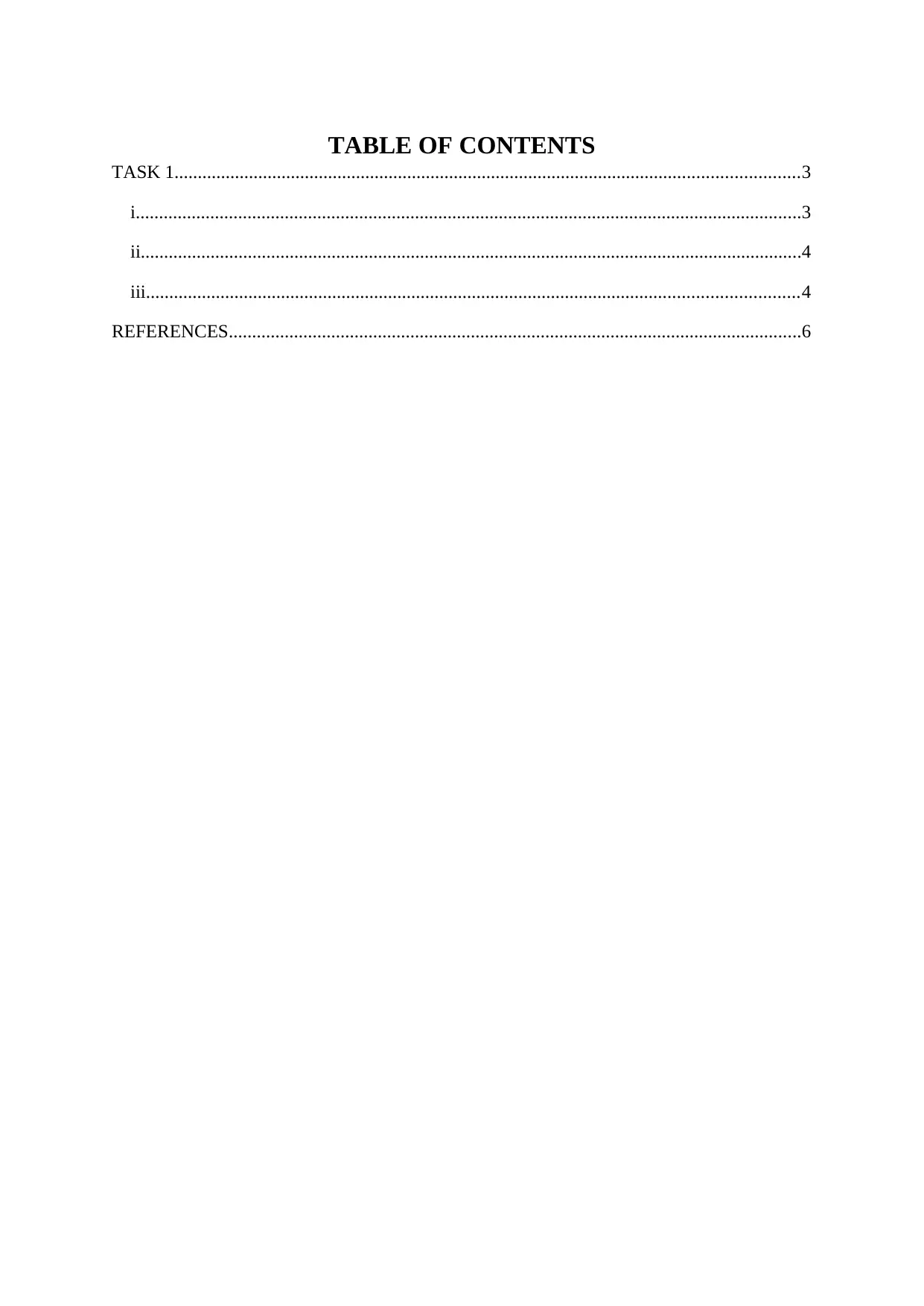
TABLE OF CONTENTS
TASK 1......................................................................................................................................3
i...............................................................................................................................................3
ii..............................................................................................................................................4
iii............................................................................................................................................4
REFERENCES...........................................................................................................................6
TASK 1......................................................................................................................................3
i...............................................................................................................................................3
ii..............................................................................................................................................4
iii............................................................................................................................................4
REFERENCES...........................................................................................................................6
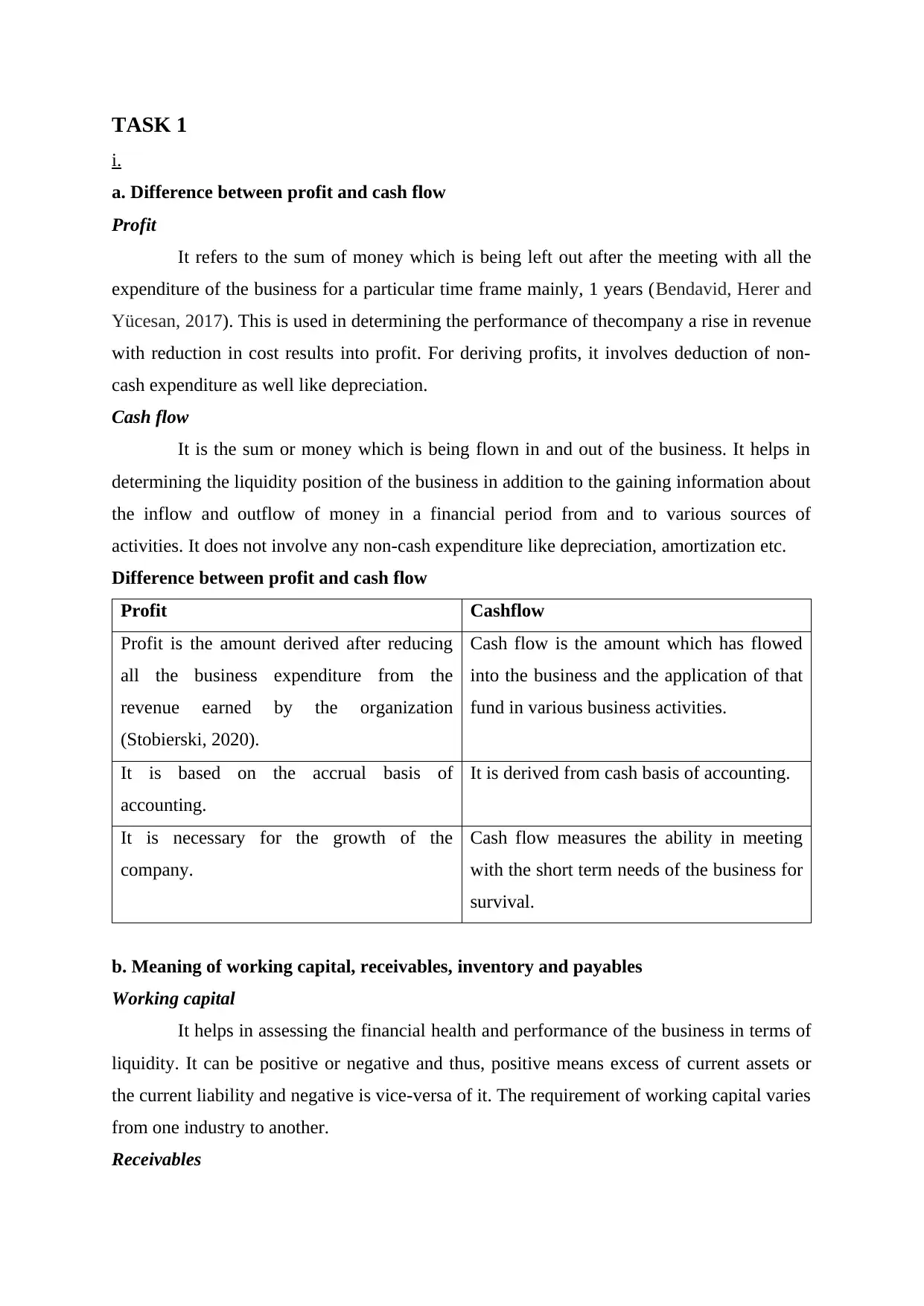
TASK 1
i.
a. Difference between profit and cash flow
Profit
It refers to the sum of money which is being left out after the meeting with all the
expenditure of the business for a particular time frame mainly, 1 years (Bendavid, Herer and
Yücesan, 2017). This is used in determining the performance of thecompany a rise in revenue
with reduction in cost results into profit. For deriving profits, it involves deduction of non-
cash expenditure as well like depreciation.
Cash flow
It is the sum or money which is being flown in and out of the business. It helps in
determining the liquidity position of the business in addition to the gaining information about
the inflow and outflow of money in a financial period from and to various sources of
activities. It does not involve any non-cash expenditure like depreciation, amortization etc.
Difference between profit and cash flow
Profit Cashflow
Profit is the amount derived after reducing
all the business expenditure from the
revenue earned by the organization
(Stobierski, 2020).
Cash flow is the amount which has flowed
into the business and the application of that
fund in various business activities.
It is based on the accrual basis of
accounting.
It is derived from cash basis of accounting.
It is necessary for the growth of the
company.
Cash flow measures the ability in meeting
with the short term needs of the business for
survival.
b. Meaning of working capital, receivables, inventory and payables
Working capital
It helps in assessing the financial health and performance of the business in terms of
liquidity. It can be positive or negative and thus, positive means excess of current assets or
the current liability and negative is vice-versa of it. The requirement of working capital varies
from one industry to another.
Receivables
i.
a. Difference between profit and cash flow
Profit
It refers to the sum of money which is being left out after the meeting with all the
expenditure of the business for a particular time frame mainly, 1 years (Bendavid, Herer and
Yücesan, 2017). This is used in determining the performance of thecompany a rise in revenue
with reduction in cost results into profit. For deriving profits, it involves deduction of non-
cash expenditure as well like depreciation.
Cash flow
It is the sum or money which is being flown in and out of the business. It helps in
determining the liquidity position of the business in addition to the gaining information about
the inflow and outflow of money in a financial period from and to various sources of
activities. It does not involve any non-cash expenditure like depreciation, amortization etc.
Difference between profit and cash flow
Profit Cashflow
Profit is the amount derived after reducing
all the business expenditure from the
revenue earned by the organization
(Stobierski, 2020).
Cash flow is the amount which has flowed
into the business and the application of that
fund in various business activities.
It is based on the accrual basis of
accounting.
It is derived from cash basis of accounting.
It is necessary for the growth of the
company.
Cash flow measures the ability in meeting
with the short term needs of the business for
survival.
b. Meaning of working capital, receivables, inventory and payables
Working capital
It helps in assessing the financial health and performance of the business in terms of
liquidity. It can be positive or negative and thus, positive means excess of current assets or
the current liability and negative is vice-versa of it. The requirement of working capital varies
from one industry to another.
Receivables
⊘ This is a preview!⊘
Do you want full access?
Subscribe today to unlock all pages.

Trusted by 1+ million students worldwide
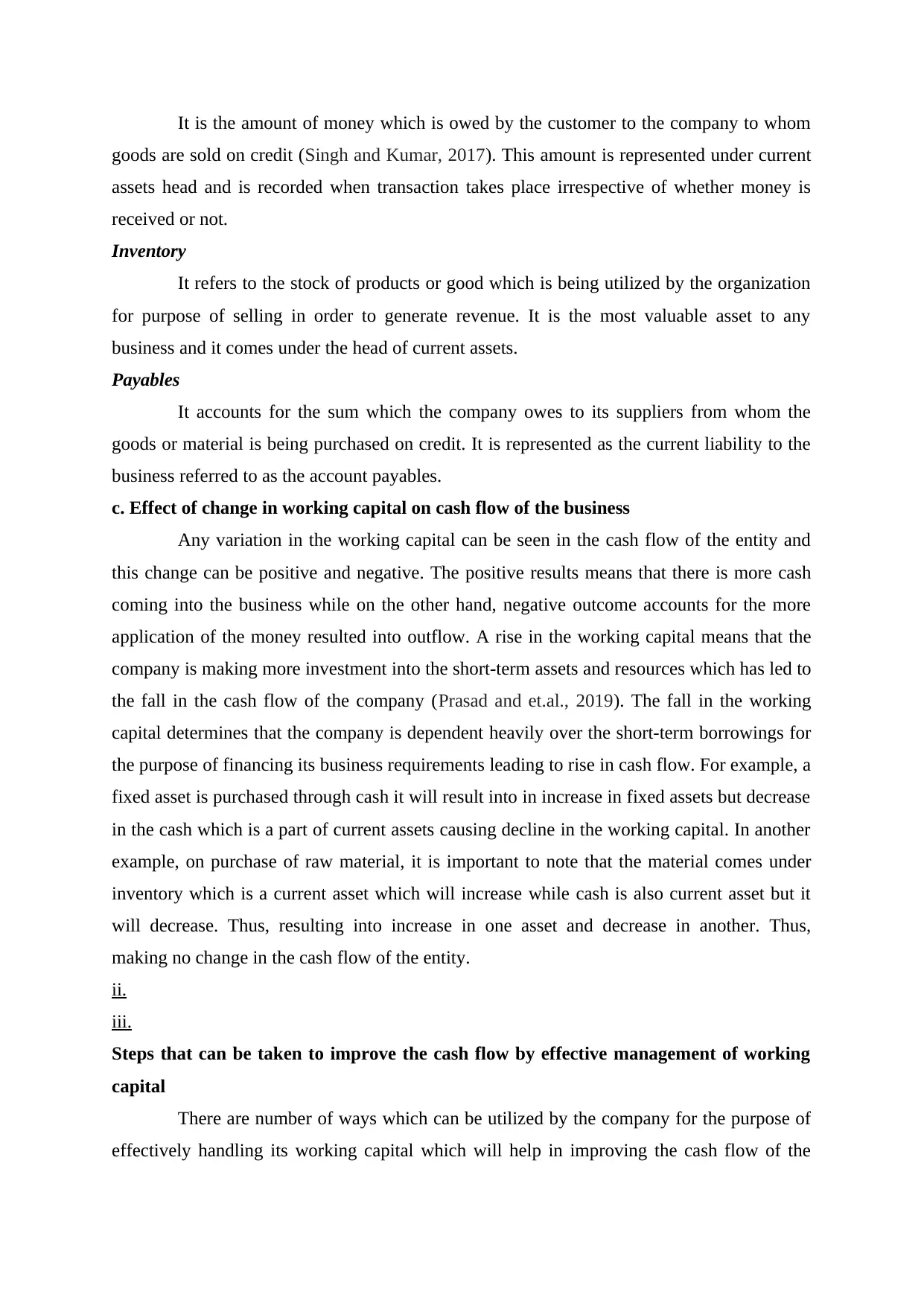
It is the amount of money which is owed by the customer to the company to whom
goods are sold on credit (Singh and Kumar, 2017). This amount is represented under current
assets head and is recorded when transaction takes place irrespective of whether money is
received or not.
Inventory
It refers to the stock of products or good which is being utilized by the organization
for purpose of selling in order to generate revenue. It is the most valuable asset to any
business and it comes under the head of current assets.
Payables
It accounts for the sum which the company owes to its suppliers from whom the
goods or material is being purchased on credit. It is represented as the current liability to the
business referred to as the account payables.
c. Effect of change in working capital on cash flow of the business
Any variation in the working capital can be seen in the cash flow of the entity and
this change can be positive and negative. The positive results means that there is more cash
coming into the business while on the other hand, negative outcome accounts for the more
application of the money resulted into outflow. A rise in the working capital means that the
company is making more investment into the short-term assets and resources which has led to
the fall in the cash flow of the company (Prasad and et.al., 2019). The fall in the working
capital determines that the company is dependent heavily over the short-term borrowings for
the purpose of financing its business requirements leading to rise in cash flow. For example, a
fixed asset is purchased through cash it will result into in increase in fixed assets but decrease
in the cash which is a part of current assets causing decline in the working capital. In another
example, on purchase of raw material, it is important to note that the material comes under
inventory which is a current asset which will increase while cash is also current asset but it
will decrease. Thus, resulting into increase in one asset and decrease in another. Thus,
making no change in the cash flow of the entity.
ii.
iii.
Steps that can be taken to improve the cash flow by effective management of working
capital
There are number of ways which can be utilized by the company for the purpose of
effectively handling its working capital which will help in improving the cash flow of the
goods are sold on credit (Singh and Kumar, 2017). This amount is represented under current
assets head and is recorded when transaction takes place irrespective of whether money is
received or not.
Inventory
It refers to the stock of products or good which is being utilized by the organization
for purpose of selling in order to generate revenue. It is the most valuable asset to any
business and it comes under the head of current assets.
Payables
It accounts for the sum which the company owes to its suppliers from whom the
goods or material is being purchased on credit. It is represented as the current liability to the
business referred to as the account payables.
c. Effect of change in working capital on cash flow of the business
Any variation in the working capital can be seen in the cash flow of the entity and
this change can be positive and negative. The positive results means that there is more cash
coming into the business while on the other hand, negative outcome accounts for the more
application of the money resulted into outflow. A rise in the working capital means that the
company is making more investment into the short-term assets and resources which has led to
the fall in the cash flow of the company (Prasad and et.al., 2019). The fall in the working
capital determines that the company is dependent heavily over the short-term borrowings for
the purpose of financing its business requirements leading to rise in cash flow. For example, a
fixed asset is purchased through cash it will result into in increase in fixed assets but decrease
in the cash which is a part of current assets causing decline in the working capital. In another
example, on purchase of raw material, it is important to note that the material comes under
inventory which is a current asset which will increase while cash is also current asset but it
will decrease. Thus, resulting into increase in one asset and decrease in another. Thus,
making no change in the cash flow of the entity.
ii.
iii.
Steps that can be taken to improve the cash flow by effective management of working
capital
There are number of ways which can be utilized by the company for the purpose of
effectively handling its working capital which will help in improving the cash flow of the
Paraphrase This Document
Need a fresh take? Get an instant paraphrase of this document with our AI Paraphraser
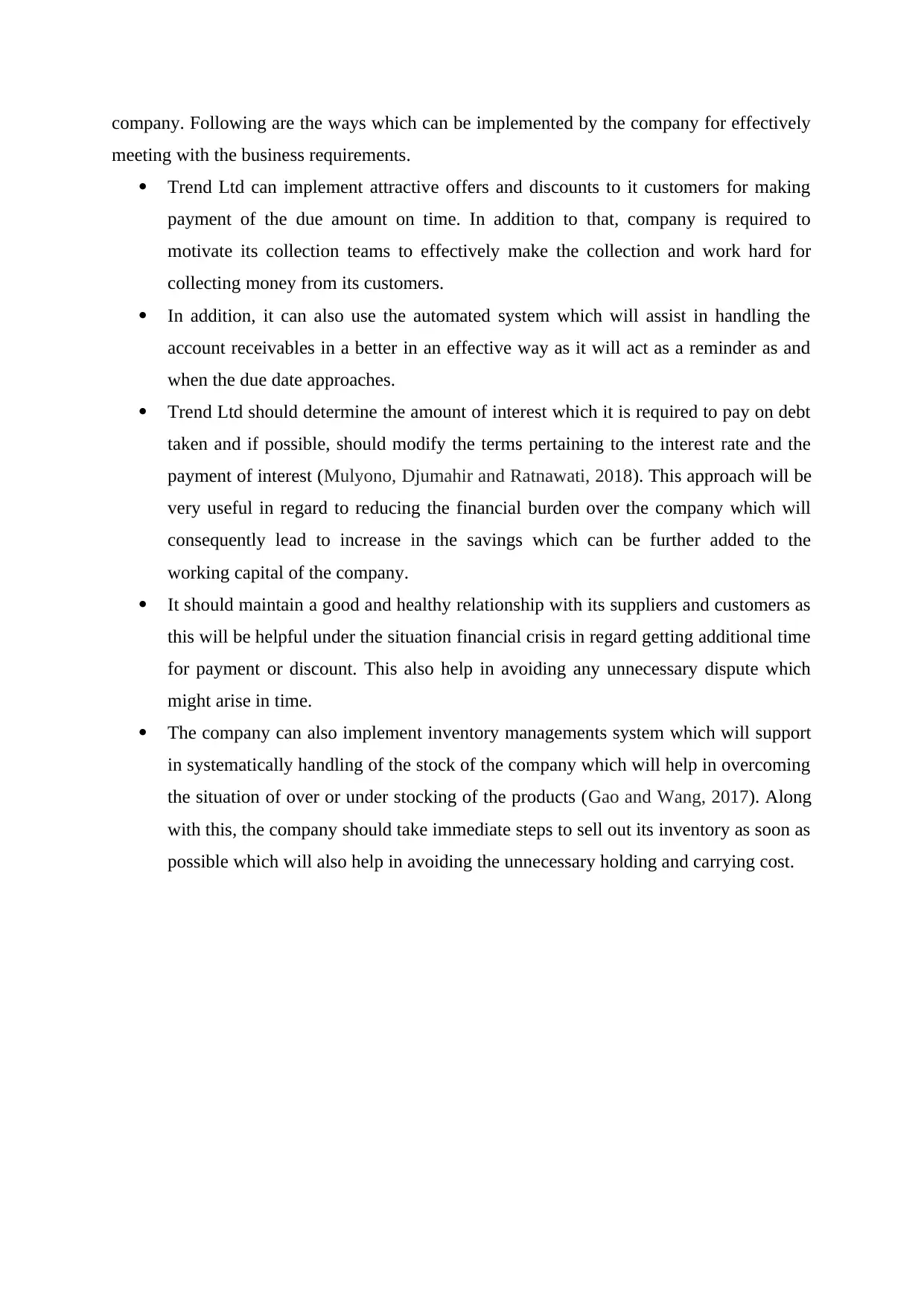
company. Following are the ways which can be implemented by the company for effectively
meeting with the business requirements.
Trend Ltd can implement attractive offers and discounts to it customers for making
payment of the due amount on time. In addition to that, company is required to
motivate its collection teams to effectively make the collection and work hard for
collecting money from its customers.
In addition, it can also use the automated system which will assist in handling the
account receivables in a better in an effective way as it will act as a reminder as and
when the due date approaches.
Trend Ltd should determine the amount of interest which it is required to pay on debt
taken and if possible, should modify the terms pertaining to the interest rate and the
payment of interest (Mulyono, Djumahir and Ratnawati, 2018). This approach will be
very useful in regard to reducing the financial burden over the company which will
consequently lead to increase in the savings which can be further added to the
working capital of the company.
It should maintain a good and healthy relationship with its suppliers and customers as
this will be helpful under the situation financial crisis in regard getting additional time
for payment or discount. This also help in avoiding any unnecessary dispute which
might arise in time.
The company can also implement inventory managements system which will support
in systematically handling of the stock of the company which will help in overcoming
the situation of over or under stocking of the products (Gao and Wang, 2017). Along
with this, the company should take immediate steps to sell out its inventory as soon as
possible which will also help in avoiding the unnecessary holding and carrying cost.
meeting with the business requirements.
Trend Ltd can implement attractive offers and discounts to it customers for making
payment of the due amount on time. In addition to that, company is required to
motivate its collection teams to effectively make the collection and work hard for
collecting money from its customers.
In addition, it can also use the automated system which will assist in handling the
account receivables in a better in an effective way as it will act as a reminder as and
when the due date approaches.
Trend Ltd should determine the amount of interest which it is required to pay on debt
taken and if possible, should modify the terms pertaining to the interest rate and the
payment of interest (Mulyono, Djumahir and Ratnawati, 2018). This approach will be
very useful in regard to reducing the financial burden over the company which will
consequently lead to increase in the savings which can be further added to the
working capital of the company.
It should maintain a good and healthy relationship with its suppliers and customers as
this will be helpful under the situation financial crisis in regard getting additional time
for payment or discount. This also help in avoiding any unnecessary dispute which
might arise in time.
The company can also implement inventory managements system which will support
in systematically handling of the stock of the company which will help in overcoming
the situation of over or under stocking of the products (Gao and Wang, 2017). Along
with this, the company should take immediate steps to sell out its inventory as soon as
possible which will also help in avoiding the unnecessary holding and carrying cost.
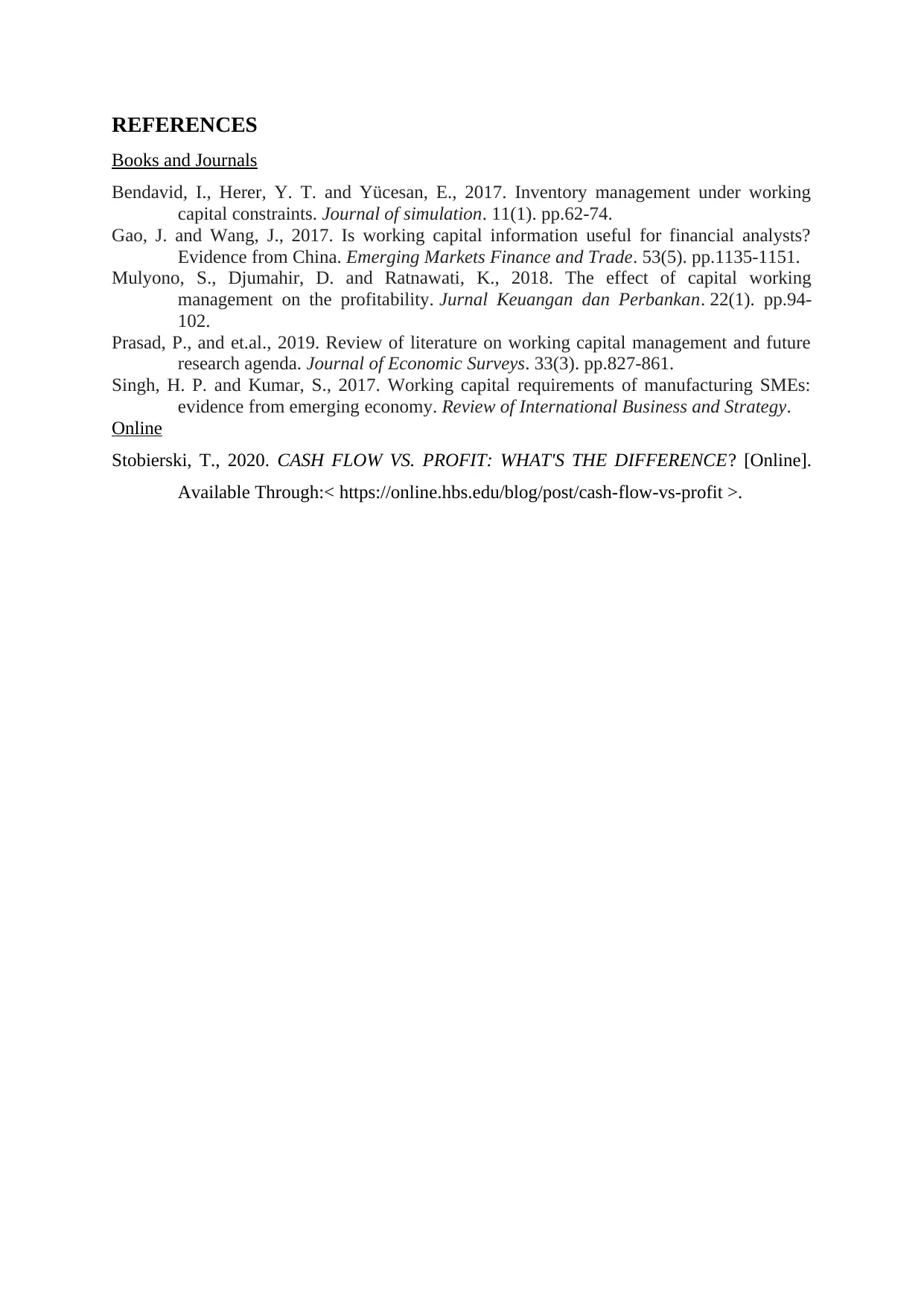
REFERENCES
Books and Journals
Bendavid, I., Herer, Y. T. and Yücesan, E., 2017. Inventory management under working
capital constraints. Journal of simulation. 11(1). pp.62-74.
Gao, J. and Wang, J., 2017. Is working capital information useful for financial analysts?
Evidence from China. Emerging Markets Finance and Trade. 53(5). pp.1135-1151.
Mulyono, S., Djumahir, D. and Ratnawati, K., 2018. The effect of capital working
management on the profitability. Jurnal Keuangan dan Perbankan. 22(1). pp.94-
102.
Prasad, P., and et.al., 2019. Review of literature on working capital management and future
research agenda. Journal of Economic Surveys. 33(3). pp.827-861.
Singh, H. P. and Kumar, S., 2017. Working capital requirements of manufacturing SMEs:
evidence from emerging economy. Review of International Business and Strategy.
Online
Stobierski, T., 2020. CASH FLOW VS. PROFIT: WHAT'S THE DIFFERENCE? [Online].
Available Through:< https://online.hbs.edu/blog/post/cash-flow-vs-profit >.
Books and Journals
Bendavid, I., Herer, Y. T. and Yücesan, E., 2017. Inventory management under working
capital constraints. Journal of simulation. 11(1). pp.62-74.
Gao, J. and Wang, J., 2017. Is working capital information useful for financial analysts?
Evidence from China. Emerging Markets Finance and Trade. 53(5). pp.1135-1151.
Mulyono, S., Djumahir, D. and Ratnawati, K., 2018. The effect of capital working
management on the profitability. Jurnal Keuangan dan Perbankan. 22(1). pp.94-
102.
Prasad, P., and et.al., 2019. Review of literature on working capital management and future
research agenda. Journal of Economic Surveys. 33(3). pp.827-861.
Singh, H. P. and Kumar, S., 2017. Working capital requirements of manufacturing SMEs:
evidence from emerging economy. Review of International Business and Strategy.
Online
Stobierski, T., 2020. CASH FLOW VS. PROFIT: WHAT'S THE DIFFERENCE? [Online].
Available Through:< https://online.hbs.edu/blog/post/cash-flow-vs-profit >.
⊘ This is a preview!⊘
Do you want full access?
Subscribe today to unlock all pages.

Trusted by 1+ million students worldwide

1 out of 7
Related Documents
Your All-in-One AI-Powered Toolkit for Academic Success.
+13062052269
info@desklib.com
Available 24*7 on WhatsApp / Email
![[object Object]](/_next/static/media/star-bottom.7253800d.svg)
Unlock your academic potential
Copyright © 2020–2025 A2Z Services. All Rights Reserved. Developed and managed by ZUCOL.





